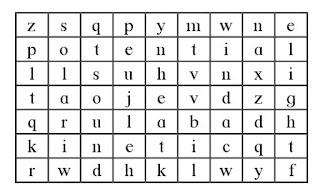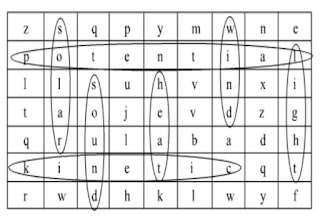Work and Energy class 6 questions and answers
- When an object is displaced by applying a force on it, work is said to be done.
- Work is done when an object undergoes displacement on application of a force.
- Energy is the capacity to do work. y The various forms of energy are mechanical energy, heat energy, light energy, sound energy, chemical energy and electrical energy.
- Something that can be used to obtain energy is called an energy resource.
- Energy resources are of two kinds: conventional (non-renewable) and non-conventional (renewable) energy resources. More work is done for the same displacement, when more force is applied to do the work.
- If the same force is applied for more displacement, more work is done by the force. The energy used for doing mechanical work is called mechanical energy.
- There are two types of mechanical energy, namely, potential energy and kinetic energy.
- Potential energy is obtained due to position and kinetic energy, by motion.
- Mechanical energy, heat, light, sound, chemical and electrical energy are the various forms of energy.
Q.1 : Fill in each blank with the appropriate term from the brackets
a) A bucketful of water is to be drawn from a well. Work will be done when a force is applied to do this, because there will be a displacement of water.
b) If a ball is dropped on the sloping roof of a house, it acquires motion and falls on the ground. That is, transformation of potential energy into kinetic energy takes place.
c) You might have seen some beautiful fireworks during Diwali. It is an example of transformation of chemical energy into light energy.
d) The solar cooker is an application of the heat energy of the sun, while solar cells, solar lamps are applications of the light energy of the sun.
e) One labourer carried four pans of road metal through a distance of 100 metres. If he carries two pans of road metal through a 200 metre distance equal work will be done.
f) The capacity that an object has for doing work is called energy.
Question 2: Match the pairs.
Group ‘A’. Group ‘B’
1) Rolling object. a) Heat energy
2) Food. b) Atomic energy
3) Stretched bow c) Kinetic energy
4) Sunlight. d) Potential energy
5) Uranium. e) Chemical energy
Answer :
1) Rolling object – c) Kinetic energy
2) Food – e) Chemical energy
3) Stretched bow – d) Potential energy
4) Sunlight – a) Heat energy
5) Uranium – b) Atomic energy
Question 3: Can you tell
a) When can we say that displacement has taken place?
Answer : We can say that displacement has taken place when the initial and final position of an object is different i.e. there is some distance between the initial and final position of an object.
b) What should be taken into account for measuring work?
Answer : While measuring work, the magnitude of force applied on an object and the displacement of an object should be taken into account.
c) What are the various forms of energy ?
Answer : Various forms of energy are:
Mechanical: Kinetic and potential energy are two types of mechanical energy.
Light
Heat
Muscular
Sound
Magnetic
Electrical
Chemical
Nuclear
d) Describe one natural chain of transformation of energy.
Answer : When a candle is lit, the chemical energy stored in its wax gets converted to heat and light energy.
e) Why should we save energy ?
Answer : We should save energy because of the following:
To save money: Wasting energy is same as wasting money. We all know that electricity we use at our homes isn’t free but costs us a lot. So, saving energy will save money too.
To preserve conventional sources: Most of the energy we use in our daily life is generated using conventional energy resources, such as coal, petroleum, etc. These energy resources are non-renewable in nature. So, if we waste energy, we are indirectly wasting these resources and hence a day will come when these resources will get extinct. So to preserve these non-renewable resources, we should save energy.
To keep environment clean: Energy saving will help us keep the environment clean. Less energy usage will result in less energy production using coal, petroleum and other conventional sources which pollutes the environment when burnt.
f) What is green energy ?
Answer : The forms of energy which do not produce smoke and carbon gases such as carbon dioxide or carbon monoxide are known as green energy.
g) What are the non-conventional energy resources ?
Answer : Non-conventional energy resources are inexhaustible in nature and can be used in various forms again and again. For example, wind energy, tidal energy, solar energy, etc. are non-conventional energy resources.
h) Which forms of energy from the sun are used in solar energy devices ?
Answer : Heat and light energy of Sun are used in solar energy devices.
i) Why should we maximise the use of non-conventional energy resources ?
Answer : Because of increase in population and usage of energy resources, there is a potential danger of limited reserves of conventional energy resources, such as coal, petrol, diesel, crude oil and natural gas, getting exhausted in future. Therefore, it will be better to maximise the use of non-conventional energy resources to remove the danger of extinction of conventional energy resources.
Question 4: Who is the odd-one-out ?
1) Diesel, crude oil, natural gas, wind
Answer : Wind is the odd one out as it is a non-conventional energy resource. The rest are conventional energy resource.
2) A running car, hauling a log, a book kept on a table, picking up the school bag
Answer : A book kept on a table is the odd one out as no work is being done in this case. In rest of the cases, work is being done.
3) Sunlight, wind, waves, petrol
Answer : Petrol is the odd one out as it is a conventional energy resource. The rest are non-conventional energy resource.
4) Leaving the fan on in a vacant room, leaving the TV on while working, using AC during winter, putting off the light when going out.
Answer : Putting off the light when going out is the odd one out as it is one of the measures of saving energy. The rest involves wastage of energy.
5. Find out the types of energy from the following puzzle
Answer :
# Use your brain power
1. Why do you get hungry after
physical exercise ?
Answer : When your glycogen stores dip during a workout, your body starts to use more of the sugar in your blood for energy. When this gets low, your blood sugar levels drop, and your body releases more ghrelin to signal to your brain that it’s time to refuel.
2. From where does our body get energy?
Answer : This energy comes from the food we eat. Our bodies digest the food we eat by mixing it with fluids (acids and enzymes) in the stomach. When the stomach digests food, the carbohydrate (sugars and starches) in the food breaks down into another type of sugar, called glucose.
3. Why do we get tired?
Answer : when our eyes see light, our brain gets signals that make us feel awake. But when its dark, the signals make us feel tired. This is part of a process called the circadian rhythm. This works like a natural clock in our body.
4. In which form is energy stored in plant food?
Answer : Plants store their energy in the form of starch, which is a complex carbohydrate that can be broken down into a simple carbohydrate (glucose) for the plant to use for energy. Plant cells store starch in storage organelles like all cells do.
5. How is energy obtained from cooking gas?
Answer: The energy is obtained via the cooking gas, which is stored in the form of the chemical bond of gas. Natural gas is the primary fossil fuel, is the mode of various of cooking and heating.
Tags : mcq on work and energy for class 6, work and energy class 6 ssc board, work and energy class 6 questions and answers, work and energy 6th standard, energy icse class 6, work and energy class 8, work energy and power class 9, work power and energy class 10


